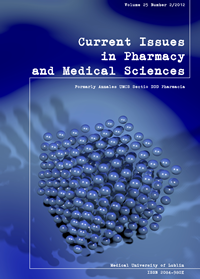A comparison of the antioxidant properties of selected edible sprouts of the Legumes family
DOI:
https://doi.org/10.12923/j.2084-980X/25.2/a.15Keywords:
Legumes family, antioxidant properties, ABTS, FRAPAbstract
Germinating seeds of the Legumes family are a natural source of valuable nutrients. The aim of the study was to compare the antioxidant properties of selected edible sprouts from the Legumes family. Lentil and mung bean seeds purchased from PNOS Ożarów Mazowiecki S.A. were used for the study. The seeds were moistened in distilled water and germinated in Petri dishes lined with filter paper, in natural light conditions, at 22°C. Two methods were used to measure the total antioxidant capacity of aqueous extracts of the seedlings: the ABTS method based on reduction of ABTS●+ cation radical and the FRAP method based on iron (III) ion reduction. The antioxidant properties were measured using the ABTS method on days 1-6 of growth. Similar antioxidant content per 1 g of fresh weight was obtained for the two kinds of sprouts (66.34 to 55.95 mmol trolox∙g-1 FW for mung beans, 72.55 to 56.98 mmol trolox∙g-1 FW for lentils). Then antioxidant content per seedling was calculated and found to increase with the time of growth; on day 6 it attained a value of 5.00 mmol trolux in the case of mung beans and 7.60 mmol trolox in the case of lentils. Similar dependencies were obtained using the FRAP method. Antioxidant content per seedling was highest on day 6 - 8.58 μmol Fe2+ equivalent for mung beans and 2.23 μmol Fe2+ equivalent for lentils. The results obtained in this study can be used to identify which sprouts have the highest antioxidant properties and to choose the optimal time for consuming them.
References
1. Anwar F et al.: Chemical composition and antioxidant activity of seeds of different cultivars of mung bean. J. Food Sci., 72, 503, 2007.
2. Barillari J et al.: Direct Antioxidant Activity of Purified Glucoerucin, the Dietary Secondary Metabolite Contained in Rocket (Eruca sativa Mill.) Seeds and Sprouts. J. Agric. Food Chem., 53, 2475, 2005.
3. Bartoń H, Fołta M, Zachwieja Z: Zastosowanie metod FRAP, ABTS i DPPH w badaniu aktywności antyoksydacyjnej produktów spożywczych. Nowiny Lekarskie, 74, 510, 2005.
4. Bartosz G (2003). Druga twarz tlenu. Wolne rodniki w przyrodzie. WN PWN, Warszawa 2003.
5. Benzie IFF., Strain JJ: The ferric reducing ability of plasma (FRAP) as a measure of antioxidant power: The FRAP Assay. Anal. Biochem., 239, 70, 1996.
6. Dueńas M et al.: Germination as a process to increase the polyphenol content and antioxidant activity of lupin seeds (Lupinus angustifolius L.). Food Chem., 117, 599, 2009.
7. Gajewski M et al.: Quality characteristics of fresh plant sprouts and after their short-term storage. Vegetable Crops Res. Bull., 68, 155, 2008.
8. Koyama M, Nakamura C, Nakamura K: Changes in phenols contents from buckwheat sprouts during growth stage. J. Food Sci. Technol., Online First 14 February 2011.
9. López-Amorós ML, Hernández T, Estrella I: Effect of germination onlegume phenolic compounds and their antioxidant activity. J. Food Compos. Anal., 19, 277, 2006.
10. Moriyama M, Oba M: Sprouts as antioxidant food resources and young people's taste for them. Biofactors, 21, 247, 2004.
11. Mubarak AE: Nutritional composition and antinutritional factors of mung bean seeds (Phaseolus aureus) as affected by some home traditional processes. Food Chem., 89, 489, 2005.
12. Okoronkwo EO, Okafor PN, Aguguo BAC: Protein and Antinutrient Constituents of Sprouted and Unsprouted Mung Beans (Phaseolus aureus). Nig. J. Biochem. Mol. Biol., 25, 55, 2010.
13. Re R et al.: Antioxidant activity applying an improved ABTS radical cation decolorization assay. Free Radic. Biol. Med., 26, 1231, 1999.
14. Rodrı´guez C et al.: Correlations between some nitrogen fractions, lysine, histidine, tyrosine, and ornithine contents during the germination of peas, beans, and lentils. Food Chem., 108, 245, 2008.
15. Samotyja U et al.: Przeciwutleniające właściwości ekstraktów z kiełków roślin. Żywność. Nauka. Technologia. Jakość, 5, 122, 2007.
16. Sharma P, Gujral HS: Antioxidant and polyphenols oxidase activity of germinated barley and its milling fractions. Food Chem., 120, 673, 2010.
17. Suk-Jun L et al.: Effect of mung bean ethanol extract on pro-inflammtory cytokines in LPS stimulated macrophages. Food Sci. Biotechnol., 20, 519, 2011.
18. Xu BJ, Chang SKC: A comparative study on phenolic profiles and antioxidant activities of Legumes as affected by extraction solvents. J. Food. Sci., 72, 159, 2007.
19. Zieliński H, Kozłowska H: Antioxidant activity and total phenolics in selected cereal grains and their different morphological fractions. J. Agric. Food Chem., 48, 2008, 2000.
Downloads
Published
Issue
Section
License
Copyright (c) 2012 Authors

This work is licensed under a Creative Commons Attribution-NonCommercial-NoDerivatives 3.0 Unported License.


